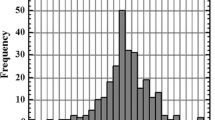Abstract
WHEN the surface of a solid target is bombarded with energetic ions or neutral atoms, spontaneous emission of ultraviolet and visible radiation is observed. When the radiation is analysed by a spectrometer, it is shown to contain characteristic lines of the constituent elements in the solid1–4. It has also been shown that this radiation is caused by the decay of excited atoms ejected from the target surface4,5. The photon emission process is more efficient in insulating targets than metallic targets. This is because of the existence of radiationless de-excitation processes which compete with radioactive decay in the case of metals but not in the case of insulators1,6. The intensities of the spectral lines are directly proportional to the bombarding ion beam current7, that is, directly proportional to the number of sputtered particles since the sputtering yield (sputtered atoms per incident ion) for a particular material is invariant if the ion energy is constant providing that the surface conditions do not alter during sputtering. In a previous report1, one of us suggested that the photon emission phenomenon may provide a new method for chemical analysis of solids, and subsequently White et al.3 demonstrated the detection sensitivity, for example 1 part per 106 for sodium in a silicate glass, which could be achieved with this technique. This communication describes some quantitative analyses of a number of feldspars. The analyses were made by comparing the intensities of the emission lines of the major constituents in these materials. In our analyses, we assume that diffusion does not occur to an appreciable extent so that the relative sputtering rates are directly proportional to the atomic concentrations in the target. Provided that self-absorption is negligible (because the ‘vapour’ density of absorbing atoms is low), then we have the condition for spectrochemical analyses (intensity is directly proportional to concentration).
Similar content being viewed by others
References
Tsong, I. S. T., Phys. stat. Sol. (a), 7, 451 (1971).
White, C. W., and Tolk, N. H., Phys. Rev. Lett., 26, 486 (1971).
White, C. W., Simms, D. L., and Tolk, N. H., Science, N.Y., 177, 481 (1972).
Kistemaker, J., and Snoek, C., Le Bombardment Ionique, 51 (CNRS, Paris, 1962).
Snoek, C., van der Weg, W. F., and Rol, P. K., Physica, 30, 341 (1964).
Tolk, N. H., Simms, D. L., Foley, E. B., and White, C. W., Rad. Effects, 18, 221 (1973).
Sawatzky, E., and Kay, E., Rev. sci. Instrum., 37, 1324 (1966).
Tsong, I. S. T., and McLaren, A. C., Australian Patent Application No. PB 4508 (August 16, 1973).
McLaren, A. C., NATO Advanced Study Institute of the Feldspars, Manchester 1972, 378–423 (Manchester University Press, 1973).
McLaren, A. C., and Marshall, D. B., Contrib. Mineral. Petrol. (in the press).
Stewart, D. B., Walker, G. W., Wright, T. L., and Fahey, J. J., Am. Mineral., 51, 177 (1966).
Author information
Authors and Affiliations
Rights and permissions
About this article
Cite this article
TSONG, I., MCLAREN, A. Quantitative Spectrochemical Analyses of Feldspars by Ion Bombardment. Nature 248, 43–45 (1974). https://doi.org/10.1038/248043a0
Received:
Revised:
Published:
Issue Date:
DOI: https://doi.org/10.1038/248043a0
- Springer Nature Limited
We’re sorry, something doesn't seem to be working properly.
Please try refreshing the page. If that doesn't work, please contact support so we can address the problem.





